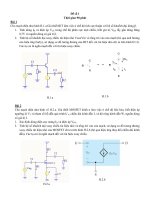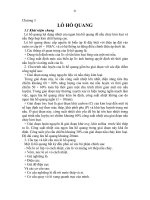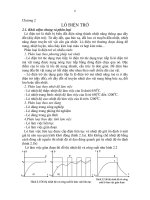Tài liệu chuyên nghành điện hạt nhân - 3 pptx
Bạn đang xem bản rút gọn của tài liệu. Xem và tải ngay bản đầy đủ của tài liệu tại đây (779.8 KB, 28 trang )
Nuclear Power Engineering at Electric Power University
Copyright © 2011 Tokyo Institute of Technology All Rights Reserved.
Safety Regulation- 1
-Deterministicvs.Probabilistic/
Fukushima-
July26,ThirdPeriod
Hiroshi UJITA
Tokyo Institute of Technology
1
Nuclear Power Engineering at Electric Power University
Copyright © 2011 Tokyo Institute of Technology All Rights Reserved.
2
Quy chế và an toàn
•
Therearegrowingtendencyintheorganizationalproblemandalsotheimpactontheenvironment,
duetowidespreadandcomplextargetsystem.
•
ShiftfromprescriptiveRegulationtoNormativeRegulation.
•
Thelegalsystemchangesfromresultstheorytoacttheory(backgroundtheory,proceduretheory,
frameworktheory).
•
Theshiftfromthepunishmentduetoaccidentoccurtothepunishmentduetonottomakethe
mechanismtopreventtheaccident.
•
AsforthePerformanceStandardRegulationintheU.S.,Risk-InformedPerformance-Based
Regulationhasbeenadoptedbasedontherisktheory.
•
AsfortheRegulatoryorganization,SafetyandEnvironmentalRegulatoryAuthorityshouldbe
establishedasintheCabinetOffice,withunifiedlookthroughouttheorganizationand
independenttotheotherauthorities.CreateanInstituteforEnvironmentandSafetyand
EnvironmentandSafetyAdvisoryCommitteetodeveloppolicies.
Nuclear Power Engineering at Electric Power University
Copyright © 2011 Tokyo Institute of Technology All Rights Reserved.
3
LawandSafety
•
Recently,frequentoverstuffedcorporatescandalsandaccidents.
•
Responsiblepersonwillfulnegligence,thatisinactionbytheostrichfashion
“hadbeenpredictedwhiledidnotconsider,”istheworst.
•
Sincethelawhasbeendesignedfororganizationalaccidentprevention
primarily,itworksbycombiningbothtechnicalandlegalmeasurestoimprove
safetymeasures.
•
Inaddition,economicandsocialsanctionsandprocedureandframeworktheory,
etc.arealsorequired.
•
Asforthesocialandeconomicsanctionsagainstorganizationalaccidents,
punitivecompensationsystemshouldalsobeconsidered.
Nuclear Power Engineering at Electric Power University
Copyright © 2011 Tokyo Institute of Technology All Rights Reserved.
•
Preventingdamage
•
Failureexpansionmitigation:autonomouscharacteristic,inherentsafety
(intrinsicallysafety)
•
Accidentprevention:afail-safe,fool-proof,redundancy,diversity
•
Accidentexpansionmitigation:confinement,controlrelease
•
Environmentaleffectsmitigation:evacuation
–
Focusonpreventingdamage,expansionmitigation,oraccident
preventiontotheforefront
–
Increasedattentiontoback-upsystems,ifithasalargeenoughimpact
ontheenvironment
4
DefenseinDepthforthesafetydesign
Nuclear Power Engineering at Electric Power University
Copyright © 2011 Tokyo Institute of Technology All Rights Reserved.
•
Deterministicapproach:
•
Safetyassessmentforeachbarriertodefenseindepth
–
Themostsevereeventisassumedtorepresentthetypicalevent,whilethe
initiatingeventsareconsideredandclassifiedbybehavior(DesignBasis
Accident)
–
Inadditiontothis,assumingthatfailureofoneofthemostimportantsafety-
relatedequipment(SingleFailureCriteria),
–
Wemayguaranteethesafetybasedontheevaluationthatwecanstillhave
enoughsafetyonthatseverehypothesis.
–
SingleFailureCriterionfailure
•
LOCA,LossofCoolantAccident,therealitywillnothappen(NRC)
•
Transientisthemostlikelyevent(ReactorSafetyStudy1975,TMI
Accident1979)
5
SystemSafetyEvaluation1
Nuclear Power Engineering at Electric Power University
Copyright © 2011 Tokyo Institute of Technology All Rights Reserved.
•
Probabilisticapproach:
•
Overallsystemsafetyassessmentbasedontheconceptofrisk
–
Easilysecuredcoverageofeventsintheprocessofconsideringtheprobability
–
Rationaldecisionsduetothepresenceofriskevaluationcriteria
-SafetyGoals:aquantitativediscussion“howsafeissafeenough”
–
Determinationofquantitativesafetytrendthroughoutthelifecycle
–
Evaluationofsafetymeasuresimplementedashardwareattheinitialsystem
construction
–
Evaluationofdailysafetyfromenteringthecommercialoperation
•
Determininginspectionfrequency,acceptablewaitingtime,etc.areinherently
risk-based
•
Chemicalplants:extensionoftimespanofperiodicinspection;1yearto2years
–
Eventsoflargeuncertaintiesanddifficulttopredictcanbequantifiedasanexpert
judge
•
Seismic(Tsunami)riskassessment,humanreliabilityassessment
6
SystemSafetyEvaluation2
Nuclear Power Engineering at Electric Power University
Copyright © 2011 Tokyo Institute of Technology All Rights Reserved.
7
Themethodologyforsafety
DeterministicApproachUseBothApproachesProbabilisticApproach
DesignMethod231
ManagementMethod122
EvaluationMethod243
4:Excellent3:
Good2:Fair1:Poor
Nuclear Power Engineering at Electric Power University
Copyright © 2011 Tokyo Institute of Technology All Rights Reserved.
•
(Successpathmethod–MissionCritical;Space,Missile)
•
PRA(ProbabilisticRiskAnalysis)SafetyCritical
–
ETA/FTA(EventTree/Faulttreeanalysis)
–
HRA (Human Reliability Analysis)
–
CMF (Common Mode Failure) Analysis
•
QRA(QuantitativeRiskAnalysis)
–
HSE(Health&SafetyExecutive)
–
ISO(InternationalStandardOrganizations)
•
FMEA(FailureMode&EffectAnalysis)
•
HAZOP(HazardousOperabilityStudy)
8
Methodologyofrisktheory
Nuclear Power Engineering at Electric Power University
Copyright © 2011 Tokyo Institute of Technology All Rights Reserved.
Study of
internal
initiating
event
Analysis of
the accident
sequences
leading to
core
damage
Analysis of
the
accident
sequences
leading to
loss of
containme
nt function
Analysis
of core
damage
accident
progressi
on
phenome
na
Core
Damage
Frequency
Source
term to
atmosphere
Analysis of
public
exposure to
atmospheric
dispersion
risk
Study of
external
initiating
events
Accident
mitigation system
reliability
analysis
Human
reliability
analysis
Occurrence
frequency of each
phenomenon
Frequency of
containment
function Loss
Level1 PSA
Level2 PSA
Level3 PSA
ProbabilisticRisk(Safety)Assessmentprocedure
9
Fukushima Daiichi Accident
Nuclear Power Engineering at Electric Power University
Copyright © 2011 Tokyo Institute of Technology All Rights Reserved.
Level1PSA
Initiating
Event
Success
Criteria
Plant
Survey
HumanError
Dependent
Failure
Uncertainty
study
Sensitivity
analysis
ComponentFailureRate
Model
(Coredamage
frequency)
Accidentsequence
quantification
FaultTree
EventTree
Phenomenapropagationscenario
10
Nuclear Power Engineering at Electric Power University
Copyright © 2011 Tokyo Institute of Technology All Rights Reserved.
InitiatingSafety SafetyConsequence FrequencyRisk
event function1 function2
11
Eventtreeanalysis(LevelofDefenseinDepth)
Succes
s
Failur
e
Success
Failur
e
Small
Medium
Large
10 - 5
10 - 6
Small
Medium
Nuclear Power Engineering at Electric Power University
Copyright © 2011 Tokyo Institute of Technology All Rights Reserved.
Initiatin
g Event
Reactor
Shut
down
Core Cooling PCV Heat Removal Core Sate
Large
LOCA
Control
Rod
Drive
Hydrauli
c System
(CRDHS)
High
Pressur
e Core
Spray
System
(HPCS)
Low
Pressur
e Core
Spray
System
(LPCS)
Low
Pressur
e Core
Injection
System
(LPCI)
Residua
l Heat
Remova
l
System
(RHR)
PCV
Vent
(PCVS)
Intact
or
Damage
Intact
Intact
Intact
Intact
Intact
Intact
damage
damage
damage
damage
damage
Level1PSA:Eventtree(ET)
12
Nuclear Power Engineering at Electric Power University
Copyright © 2011 Tokyo Institute of Technology All Rights Reserved.
13
Faulttreeanalysis
(EachfunctionofDefenseinDepth)
SafetyFunctionSLoss
SafetyFunctionB2LossSafetyFunctionB1Loss
SafetyFunctionBLossSafetyFunctionALoss
ANDgate
ORgate
P(A+B+C)
=P(A)+P(B)+P(C)
-P(AB)-P(BC)-P(CA)
+P(ABC)
P(ABC)=P(A)P(B)P(C)
S=A*B
=A*B1+A*B2
(MinimalCutset)
Nuclear Power Engineering at Electric Power University
Copyright © 2011 Tokyo Institute of Technology All Rights Reserved.
Low Pressure Core Injection System (LPCI) Function Loss
Safety Function A Loss Safety Function C LossSafety Function B Loss
Pump FailureValve
Failure
Human Error
Recovery
Failure
Support System
(Electric Power,
Cooling Function,
etc.) Failure
Mechanical Failure
Common Mode
Failure
Electrical Failure
AND
OR
OR
Level1PSA:Faulttree(FT)
14
Nuclear Power Engineering at Electric Power University
Copyright © 2011 Tokyo Institute of Technology All Rights Reserved.
試験に関連するすべての
リスク寄与(RT)
試験により制限できる
リスク寄与(RD)
試験により引き起こされ
るリスク寄与(RC)
リスク
サーベランス試験間隔
15
Risk contribution due to Surveillance test
period
Risk
Surveillancetestperiod
Totalriskcontribution
duetoSurveillancetestperiod
Riskcontribution
inducedbySurveillancetest
(Humanerror,Fatigue,etc.)
Riskcontribution
reducedbySurveillancetest
(MechanicalFailure)
Nuclear Power Engineering at Electric Power University
Copyright © 2011 Tokyo Institute of Technology All Rights Reserved.
Level2PSA
Level1PSA
Accident Sequence
Plant Degradation
Classification
Phenomena,
Accident
Mitigation
PCV Event Tree
Accident Propagation
Anaysis
PCV Event Tree
Quantification
Uncertainty
Analysis
Analysis
Propagation after
Core Damage
Typical
Accident
Scenario
Event Occurrence Time,
Accident Mitigation capability
PCVDamage
SourceTerm
16
Nuclear Power Engineering at Electric Power University
Copyright © 2011 Tokyo Institute of Technology All Rights Reserved.
SevereAccident
PhenomenainPCV
17
Insulation
Over Heat
Hydrogen
Burning
Steam
Explosion
Steam
Explosion
PCV Direct Heating
Melt Direct Contact
Incondensable Gas
Accumlation
Melt- Concrete Interaction
Nuclear Power Engineering at Electric Power University
Copyright © 2011 Tokyo Institute of Technology All Rights Reserved.
Group 1.
& Group 5.
Group 2.
Group 3.
& Group 5.
10
-7
10
-6
10
-5
10
-4
10
-3
10
-2
10
-1
10
0
-10 0 10 20 30
Source Terms (-)
Time to PCV Failure from Core Melt Initiation (h)
Group 3.&
Group 4.
Group 3.
Group 2. &
Group 4.
Failure location Xe CsI Sr
Drywell
× ● ○
Gas space in wetwell
+ ▲ △
Bottom of wetwell (liquid part)
*
■ □
FPreleaseandaccident
propagationare
categoraizedbysameway
FPreleasewilldecrease
duetonaturalfall,ifthe
timetoPCVfailuretocore
meltinitiationprolonged
RadioactiveRelease
toAtmosphere
18
Nuclear Power Engineering at Electric Power University
Copyright © 2011 Tokyo Institute of Technology All Rights Reserved.
Level3PSA
Uncertainty
Analysis
Dominant Sequence Frequency
Level2 PS A
Source Term
Prome Model
Individual Risk
Societal Risk
Risk Evaluation
Atmosphere Data
Fission Product
Releace Analysis
Wind Data
Release tendency
Capital Data
19
Nuclear Power Engineering at Electric Power University
Copyright © 2011 Tokyo Institute of Technology All Rights Reserved.
20
Risksensitivityoftheforcontainmentleakage
0.1 1 10 100 1000
400
300
200
100
0
Publicexposureexpectation
(Man-Rem/year)
Containmentleakagerate(%/day)
Plant
GrandGulf
Oconee
PeachBottom
Surry
Nuclear Power Engineering at Electric Power University
Copyright © 2011 Tokyo Institute of Technology All Rights Reserved.
21
PrincipleofsafetygoalinUK
Regionwidelyaccepted
Regionnotaccepted
Negligiblerisk
Tolerable,
iftheriskreductioncostis
abovetheimprovementbenefit
Tolerable,
iftheriskreductionisnotpossibleor
ifthecostisnotworthimprovement
Riskisnotjustified
Safety
Limit
Safety
Goal
LargeRisk
Continuetoensurethat
riskismaintainedatthislevel
Risk
Benefit
Analysis
Tolerableregion
ALARPregion
Nuclear Power Engineering at Electric Power University
Copyright © 2011 Tokyo Institute of Technology All Rights Reserved.
10
-10
10
-9
10
-8
10
-7
10
-6
10
-5
10
-4
10
-3
10
-10
10
-9
10
-8
10
-7
10
-6
10
-5
10
-4
10
-3
BWR
PWR
CDF (1/(r.y))
Index2:ContainmentFailureFrequency
Index1:CoreDamageFrequency
PSAResultofInternalEventin
NormalOperationfor52Plants
showstobelessthan
performancegoal
NISA,PSAMethodologyAfterAccident
ManagemantPublished(Oct.2004)
CoreDamageandContainmentFailureFrequency
for52PlantsinJapan
22
Nuclear Power Engineering at Electric Power University
Copyright © 2011 Tokyo Institute of Technology All Rights Reserved.
23
FukushimaDaiichiaccidentissues
•
"Assumingwhilenotconsideringsuchevent!“
–
HumanFactor&CommonModeFailurearealwaysworthkeepinginmind
•
RareEventishighconsequencewithlowfrequency.
–
Lowconsequencewithhighfrequencyeventiseasytotreatbycommercialreason,whileitisvery
difficulttohandletherareeventeventheriskisjustthesame.
–
Unexpectedeventhasbeenusedfrequently,butitistherisk-benefitissuestoassumeornot.
TsunamiProbabilisticRiskAnalysishasbeencarriedout,andsafetyrelatedpersonnelknewthe
magnitudeoftheeffectwell.
–
Regardlessoftheinitiatingevent,lackofmeasuresto“CompleteLossofPower”istobeasked.
–
Anyway,rareeventoccurredononeoccasion,measureshadtobetaken.
–
FukushimaDaiichNuclearpowerplantsas“NationalPrivatization”destroyedbylarge-scale
disastersshouldbetakensameasinfrastructuresystemsasanationalpolicy.
•
TherearemanyCrisisManagementproblemsasfollows;
–
Delayininitialresponse
–
Delayindecisionmaking
–
Delayinexternalsupportrequest
–
Poorcollaborationamonggovernment(PrimeMinisterKan),bureaucrats(NISA,JNES),and
interestedparty(TEPCO)
–
Poorinformationdisclosureinemergencysituation
•
Afterall,itisamatteroforganizationalculture.
Nuclear Power Engineering at Electric Power University
Copyright © 2011 Tokyo Institute of Technology All Rights Reserved.
24
Energyissueandroleofnuclearenergyafterthe
FukushimaDaiichiAccident
•
Premisehereisthat"Globalwarmingisaninvariantproblem!“
–
"Energysecurityisalsoaninvariantproblem!".
•
Thelong-termenergydemandandsupplysimulationtominimizethetotalenergysystemcostwas
conductedforenergypredictionduringthe21stCenturyintheworld.
•
Takingtheeffortforenergy-savingasmajorpremise,carbon-sequestrationforfossilfuel,renewable
energyandnuclearenergyshouldbealtogetherdeveloped,whichmeansenergybestmixisachieved,
undertheCO2constraintaround450ppmatmosphere.
•
Nuclearphase-outscenario,inwhichnewnuclearplantconstructionisprohibited,ispossibleeven
consideringtheissueofglobalwarming,fromsimulationforthe21stCenturyenergypredictions
–
increaseenergycosts
–
littleroomforcountermeasureandlargeuncertaintiesoftechnology
•
Therefore,rationaluseofnuclearpowerisrequested,thatiseachcountryshouldmakedecision
–
JapanandseveralEuropeancountrieswillbealsophaseout
–
China,IndiaandASEANcountrieswillcontinuetobeintroduced
•
Iftheaccidenthappensagainanywherein,itwillbecometheglobalphase-out.
•
Intheworld,rationalunifiedsafetystandards(organizationalstructure,designandoperation,regulations)
shouldbereviewedbasedontheFukushimaDaiichiProblemworld-wideanalysisandestablished.
Nuclear Power Engineering at Electric Power University
Copyright © 2011 Tokyo Institute of Technology All Rights Reserved.
25
LessonLearnedfromFukushima‐DaiichiNuclearAccident
May9th,2011,TechnicalAnalysisSubcommittee,CommitteeforNuclear
SafetyInvestigation,AtomicEnergySocietyofJapan
-SummaryofImportantLessons
a.Estimatedtsunamiwastoosmall.
b.SafetySystemandComponentsweredamagedbecauseofseawaterflooding,
resultinginsevereaccidents.
c.Long‐termstationblackoutcausedtheaccidentsprogression.
d.Reactorparametermonitoringwasdifficultwithoutelectricity.
e.Seawatercoolingsystemwasvulnerabletotsunami.
f.AccidentManagement(AM)forlong‐termstationblackoutmaybeinsufficient.
g.Hydrogenexplosionatoutsidethecontainmentvessel(CV)wasnotconsidered.
h.Enclosureofradioactivematerialsatspentfuelpoolisdifficultifreactorbuildingwas
damaged.
i.Insufficientsafetydesignforexternalevent.
j.Japanesesafetyregulationsystemisinsufficient.
k.Publicfeelsthattheinformationdisclosureisnotenough.
l.AMactivitiespreventsignificantdeteriorationoftheaccidents.
m.SeismicDesignfortheearthquakewasconsideredeffectiveinmanycases.









